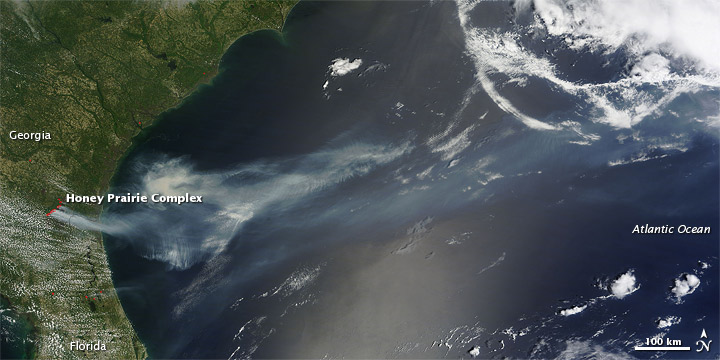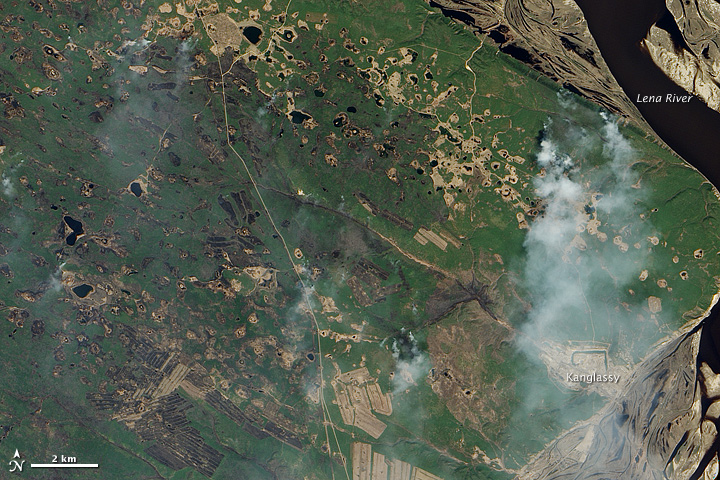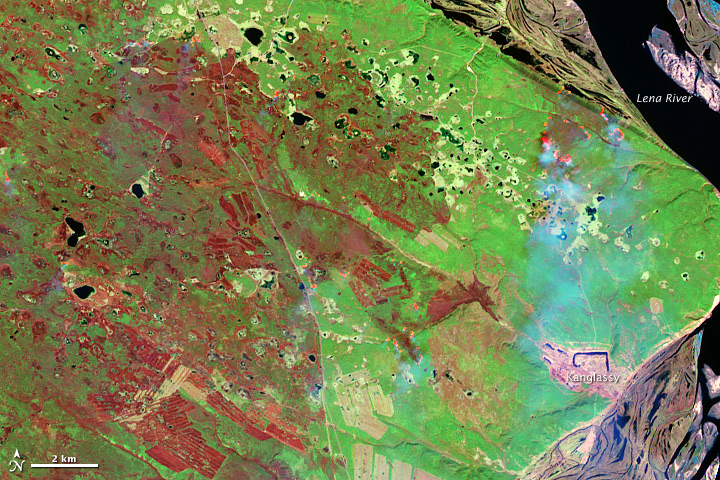Nasa: United States - Smoke from Honey Prairie Complex Fire. Georgia - Russia - Fires near Yakutsk - Lena River - Fires - 29-06-11
Posted by Ricardo Marcenaro | Posted in Nasa: United States - Smoke from Honey Prairie Complex Fire. Georgia - Russia - Fires near Yakutsk - Lena River - Fires - 29-06-11 | Posted on 20:49
Open your mind, your heart to other cultures
Abra su mente, su corazón a otras culturas
You will be a better person
Usted será una mejor persona
RM
Abra su mente, su corazón a otras culturas
You will be a better person
Usted será una mejor persona
RM
acquired June 20, 2011
The Honey Prairie Complex Fire in Georgia continued sending smoke eastward over the Atlantic Ocean on June 20, 2011. The Moderate Resolution Imaging Spectroradiometer (MODIS) on NASA’s Terra satellite took this picture the same day.
Red outlines indicate actively burning fires. Although the Honey Prairie Complex Fire produces most of the smoke, other fires also burn around the Georgia-Florida border. On June 22, the U.S. Air Quality “Smog Blog” reported that smoke from fires in Georgia and Florida was blowing northward, adding to the smoke already hovering over North Carolina.
According to the Incident Information System (InciWeb) on June 22, 2011, the Honey Prairie Complex Fire had burned 266,320 acres (107,776 hectares) and was 60 percent contained.
The bright area at the bottom center of this image results not from smoke but from sunglint—sunlight reflecting off the ocean surface and into the satellite sensor.
Red outlines indicate actively burning fires. Although the Honey Prairie Complex Fire produces most of the smoke, other fires also burn around the Georgia-Florida border. On June 22, the U.S. Air Quality “Smog Blog” reported that smoke from fires in Georgia and Florida was blowing northward, adding to the smoke already hovering over North Carolina.
According to the Incident Information System (InciWeb) on June 22, 2011, the Honey Prairie Complex Fire had burned 266,320 acres (107,776 hectares) and was 60 percent contained.
The bright area at the bottom center of this image results not from smoke but from sunglint—sunlight reflecting off the ocean surface and into the satellite sensor.
-
References
- InciWeb. (2011, June 22). Honey Prairie Complex. Accessed June 22, 2011.
- U.S. Air Quality. (2011, June 22). Fires continue to burn in Georgia, smoke heads towards already smoky North Carolina. Accessed June 22, 2011.
- U.S. Forest Service. (2011, June 22). Active Fire Mapping Program. Accessed June 22, 2011.
NASA image courtesy Jeff Schmaltz, MODIS Rapid Response Team, Goddard Space Flight Center. Caption by Michon Scott.
- Instrument:
- Terra - MODIS
acquired May 24, 2011
Deep green needle-leaf forests stretch away from the Lena River in Russia’s remote eastern reaches. Siberian larch trees mingle with patches of fragrant pine, while brush and moss cling to the ground. Unlike most coniferous trees, the larch sheds its needles at the end of the year, coating the forest floor with a flammable layer of dry, yellow kindling.
When winter’s snow melts away and the ground dries out, the larch forest is very prone to fire, particularly in May and June. The Advanced Land Imager (ALI) on NASA’s Earth Observing-1 (EO-1) satellite captured these images on May 24, 2011, just after fire swept through the forest. The top image shows the burning landscape in natural color. The land is faintly charred, and smoke pours from the edge of the burned area where the fire was still active.
The lower image, made from a combination of visible and infrared light, provides a clearer view of the severity of the burn. Places that burned completely are brick red. Much of the burned area is spotted with green, revealing trees that survived the fire. Hot spots along the edges glow orange.
The fire in this image is one of many that swept through the boreal forests of far eastern Russia in late May and early June. Though it’s not possible to tell what started this particular fire from an image alone, 90 percent of fires within 90 kilometers of a settlement are set by people, says Slava Kharuk of the Sukachev Institute of Forests in Krasnoyarsk. Outside that area, 40 percent of the fires are set by people and 60 percent are caused by lightning.
Regardless of how the fire started, the image includes signs of people in the area. Thin tan lines—roads—cross the image, and some of the burned areas are perfect rectangles where no plants survived the fire. It is possible that the fire that burned the wider area escaped from one or more of these human-controlled areas. The wider wild fire appears to have been less intense, sparing pockets of forest.
Thousands of kilometers away, scientists on the EO-1 team breathed a sigh of relief when they learned that the forest survived. The site hosts two observation towers with instruments that monitor the health of the forest. Scientists at NASA compare these measurements to data from the Hyperion instrument, which shares the EO-1 satellite with the Advanced Land Imager. The comparison with ground-based data helps scientists understand what Hyperion measurements say about the forest. The Hyperion measurements in turn help monitor forests around the world.
When winter’s snow melts away and the ground dries out, the larch forest is very prone to fire, particularly in May and June. The Advanced Land Imager (ALI) on NASA’s Earth Observing-1 (EO-1) satellite captured these images on May 24, 2011, just after fire swept through the forest. The top image shows the burning landscape in natural color. The land is faintly charred, and smoke pours from the edge of the burned area where the fire was still active.
The lower image, made from a combination of visible and infrared light, provides a clearer view of the severity of the burn. Places that burned completely are brick red. Much of the burned area is spotted with green, revealing trees that survived the fire. Hot spots along the edges glow orange.
The fire in this image is one of many that swept through the boreal forests of far eastern Russia in late May and early June. Though it’s not possible to tell what started this particular fire from an image alone, 90 percent of fires within 90 kilometers of a settlement are set by people, says Slava Kharuk of the Sukachev Institute of Forests in Krasnoyarsk. Outside that area, 40 percent of the fires are set by people and 60 percent are caused by lightning.
Regardless of how the fire started, the image includes signs of people in the area. Thin tan lines—roads—cross the image, and some of the burned areas are perfect rectangles where no plants survived the fire. It is possible that the fire that burned the wider area escaped from one or more of these human-controlled areas. The wider wild fire appears to have been less intense, sparing pockets of forest.
Thousands of kilometers away, scientists on the EO-1 team breathed a sigh of relief when they learned that the forest survived. The site hosts two observation towers with instruments that monitor the health of the forest. Scientists at NASA compare these measurements to data from the Hyperion instrument, which shares the EO-1 satellite with the Advanced Land Imager. The comparison with ground-based data helps scientists understand what Hyperion measurements say about the forest. The Hyperion measurements in turn help monitor forests around the world.
NASA Earth Observatory image created by Jesse Allen and Robert Simmon, using EO-1 ALI data provided courtesy of the NASA EO-1 team. Caption by Holli Riebeek with information from Petya Campell, Hyperion Science team, and Slava Kharuk, Sukachev Institute of Forests.
- Instrument:
- EO-1 - ALI
Nasa: United States - Smoke from Honey Prairie Complex Fire. Georgia - Russia - Fires near Yakutsk - Lena River - Fires - 29-06-11
You have an alphabetical guide in the foot of the page in the blog: solitary dog sculptor
In the blog: Solitary Dog Sculptor I, the alphabetical guide is on the right side of the page
Thanks
Usted tiene una guía alfabética al pie de la página en el blog: solitary dog sculptor
En el blog: Solitary Dog Sculptor I, la guia alfabética está en el costado derecho de la página
Gracias
Ricardo M Marcenaro - Facebook
Blogs in operation of The Solitary Dog:
solitary dog sculptor:
http://byricardomarcenaro.blogspot.com
Solitary Dog Sculptor I:
http://byricardomarcenaroi.blogspot.com
Para:
comunicarse conmigo,
enviar materiales para publicar,
propuestas comerciales:
marcenaroescultor@gmail.com
For:
contact me,
submit materials for publication,
commercial proposals:
marcenaroescultor@gmail.com
Diario La Nación
Argentina
Cuenta Comentarista en el Foro:
Capiscum
My blogs are an open house to all cultures, religions and countries. Be a follower if you like it, with this action you are building a new culture of tolerance, open mind and heart for peace, love and human respect.
Thanks :)
Mis blogs son una casa abierta a todas las culturas, religiones y países. Se un seguidor si quieres, con esta acción usted está construyendo una nueva cultura de la tolerancia, la mente y el corazón abiertos para la paz, el amor y el respeto humano.
Gracias :)





Comments (0)
Publicar un comentario